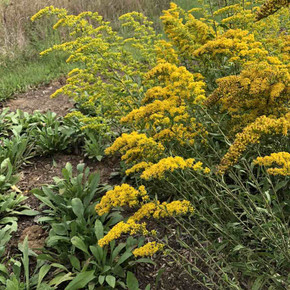
Solidago drummondii - CLIFF GOLDENROD
Low growing, nicely arching goldenrod for edges, raised beds, retaining walls or bigger rock gardens. Well behaved, doesn't seed much around and stays in clumps.
Pollinator magnet as any other goldenrod.
Blooming Time: August - September
Size: usually 18-24" tall x 24-26" wide
USDA Zones: 4/5 to 8
Culture: sun, half sun, grows well in average soils, if they are drained well (amended with gravel, sand, etc). Medium, medium-dry to dry soil. Grows fairly well in lean or shallow soil. Adaptable, avoid waterlogged soils! Very drought tolerant.
Moisture Needs: medium (average), medium-dry to dry
Origin: Native to Illinois, Missouri, Arkansas and Louisiana, where can be found on cliffs, ledges, bluffs, close to rock formations, often on leaner, shallow or poor soils.
Black Walnut Tolerant: yes
Deer/Rabbit Resistant: It's not preferred, but might be browsed by the deer if the pressure is higher or high.
Attracts Butterflies or Pollinators: yes / yes. Not much information is known about this goldenrod, but in general it does attract many insect as the other goldenrods - from honeybees, native bees (bumblebees, cuckoo bees, leaf-cutter bees, long-horned bees, ittle carpenter bees, green metallic bees, Halictid bees, plasterer bees, masked bees, Andrenid bees, dagger bees, ground beetles, ladybird beetles), Sphecid wasps, Vespid wasps, Tiphiid wasps, Syrphid flies, bee flies, Tachinid flies, flesh flies, blow flies, Muscid flies, butterflies, and day-flying moths. Host plant for the larvae of a leaf beetle (Microrhopala excavata), and possibly fort other leaf beetles, leaf-mining flies, gall flies, plant bugs, stink bugstreehoppers grasshoppers, several moths etc.
Attracts Hummingbirds: no / but small songbirds are attracted to the seeds
Pot Size:square 3.5" x 4" deep perennial pot
Plant Combinations: Best in places, where it can arch down - raised beds, dry walls, edges, or edges of sunny beds, cottage garden, naturalistic gardens. Good with many common perennials that tolerate drained or drier soils : Echinacea, Achillea, Agastache, Amsonia, summer blooming Allium, Asclepias tuberosa, Aster, Baptisia, Calamintha, Coreopsis, Gaura, Knautia, Liatris, Monarda, Nepeta, Oenothera, Penstemons, Platycodon (taller ones), Rudbeckia, Salvia nemorosa hybrids, tall Sedum, Solidago, Stachys, Vernonia lettermannii, taller Veronica, Yucca, and grasses like Bouteloa, Muhlenbergia, Sporobolus, Schizachyrium scoparium, Sorghastrum or Panicum.
Picture Copyright: 1 - Missouri Botanical Garden 2 - US Perennials

Solidago drummondii - CLIFF GOLDENROD
Low growing, nicely arching goldenrod for edges, raised beds, retaining walls or bigger rock gardens. Well behaved, doesn't seed much around and stays in clumps.
Pollinator magnet as any other goldenrod.
Blooming Time: August - September
Size: usually 18-24" tall x 24-26" wide
USDA Zones: 4/5 to 8
Culture: sun, half sun, grows well in average soils, if they are drained well (amended with gravel, sand, etc). Medium, medium-dry to dry soil. Grows fairly well in lean or shallow soil. Adaptable, avoid waterlogged soils! Very drought tolerant.
Moisture Needs: medium (average), medium-dry to dry
Origin: Native to Illinois, Missouri, Arkansas and Louisiana, where can be found on cliffs, ledges, bluffs, close to rock formations, often on leaner, shallow or poor soils.
Black Walnut Tolerant: yes
Deer/Rabbit Resistant: It's not preferred, but might be browsed by the deer if the pressure is higher or high.
Attracts Butterflies or Pollinators: yes / yes. Not much information is known about this goldenrod, but in general it does attract many insect as the other goldenrods - from honeybees, native bees (bumblebees, cuckoo bees, leaf-cutter bees, long-horned bees, ittle carpenter bees, green metallic bees, Halictid bees, plasterer bees, masked bees, Andrenid bees, dagger bees, ground beetles, ladybird beetles), Sphecid wasps, Vespid wasps, Tiphiid wasps, Syrphid flies, bee flies, Tachinid flies, flesh flies, blow flies, Muscid flies, butterflies, and day-flying moths. Host plant for the larvae of a leaf beetle (Microrhopala excavata), and possibly fort other leaf beetles, leaf-mining flies, gall flies, plant bugs, stink bugstreehoppers grasshoppers, several moths etc.
Attracts Hummingbirds: no / but small songbirds are attracted to the seeds
Pot Size:square 3.5" x 4" deep perennial pot
Plant Combinations: Best in places, where it can arch down - raised beds, dry walls, edges, or edges of sunny beds, cottage garden, naturalistic gardens. Good with many common perennials that tolerate drained or drier soils : Echinacea, Achillea, Agastache, Amsonia, summer blooming Allium, Asclepias tuberosa, Aster, Baptisia, Calamintha, Coreopsis, Gaura, Knautia, Liatris, Monarda, Nepeta, Oenothera, Penstemons, Platycodon (taller ones), Rudbeckia, Salvia nemorosa hybrids, tall Sedum, Solidago, Stachys, Vernonia lettermannii, taller Veronica, Yucca, and grasses like Bouteloa, Muhlenbergia, Sporobolus, Schizachyrium scoparium, Sorghastrum or Panicum.
Picture Copyright: 1 - Missouri Botanical Garden 2 - US Perennials










